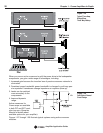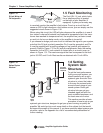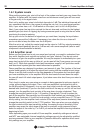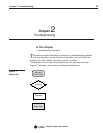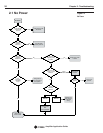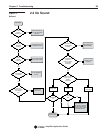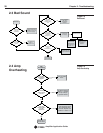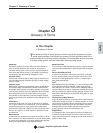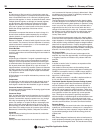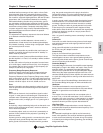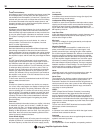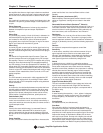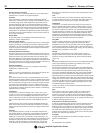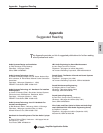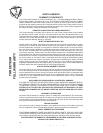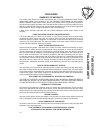
28 Chapter 3: Glossary of Terms
Amplifi er Application Guide
Bus
In audio terms, a Bus is a point in a circuit where many sig-
nals are brought together. For example: Most electronic items
have a Ground Bus where all of a device’s individual ground
paths are tied together. In mixers, we have Mix Busses, where
multiple channels’ signals are brought (or blended) together,
and Aux Busses, where feeds from channels are brought
together to be routed to an external processor or monitor
send, etc. In general, the more busses a mixer has, the more
fl exible the routing capabilities of that mixer will be.
Capacitor
An electronic component that stores an electric charge. It is
formed of two conductive plates separated by an insulator
called a dielectric. A capacitor passes AC but blocks DC.
Channel Separation
Relates to crosstalk, or bleed of audio signals from one chan-
nel to another. The amount of channel separation is inversely
related to the item’s crosstalk spec; i.e. a low crosstalk spec
indicates high channel separation.
Circuit Breaker
A resettable device intended to provide protection to electrical
circuits. It opens when current fl ows though it that exceeds its
current rating.
Clipping
A specifi c type of distortion. If a signal is passed through an
electronic device which cannot accommodate its maximum
voltage or current requirements, the waveform of the signal
is sometimes said to be clipped, because it looks on a scope
like its peaks have been clipped off by a pair of scissors. A
clipped waveform contains a great deal of harmonic distortion
and often sounds very rough and harsh. Clipping is what typi-
cally happens when an audio amplifi er output is overloaded
or its input over driven.
A Clip Indicator on an amplifi er indicates the presence of clip-
ping distortion.
Compressor
A compressor is a device that reduces the dynamic range of
an audio signal. First a threshold is established. When the
audio signal is louder than this threshold, its gain is reduced.
Crossover Network (Crossover)
An electronic network that divides an incoming signal into two
or more frequency bands.
Crossover Slope
High- and low-pass fi lters used for speakers do not cut off fre-
quencies like brick walls. The roll-off occurs over a number of
octaves. Common fi lter slopes for speakers are 1st- through
4th-order corresponding to 6 dB per octave to 24 dB per
octave. For example, a 1st-order, 6 dB per octave high-pass
fi lter at 100 Hz will pass 6 dB less energy at 50 Hz, and 12
dB less energy at 25 Hz. Within the common 1st through 4th
fi lters there is an endless variety of crossover types including
Butterworth, Linkwitz-Riley, Bessel, Chebychev and others.
Crosstalk
Signal bleeding or leaking from one channel of a multi-chan-
nel device to another.
Current
Literally, the rate of electron fl ow in an electrical circuit. Cur-
rent is measured in Amperes (or Amps), abbreviated I. Ohms
law defi nes current as voltage (V) divided by resistance (R)
with the following expression: I=V/R.
Damping Factor
Though technically more complex than this, damping factor
is usually thought of as an indicator of how tight an amplifi er
will sound when powering bass speakers. A speaker’s driving
motor is a coil of wire (called a voice coil) mounted within a
magnetic fi eld. As this coil of wire moves within the fi eld a
voltage will be induced in the voice coil. If resonant motions of
the speaker are not suffi ciently short-circuited by the ampli-
fi er, the speaker output can have an over accentuated or
“boomy” bass sound.
From a technical measurement stand point, damping factor
is the ratio of the rated speaker impedance to the amplifi er’s
output impedance. Low output impedance is the consequence
of the amplifi er having substantial negative voltage feedback
taken from its output terminals. Properly designed negative
feed back not only corrects for output voltage errors induced
by the speaker but also produces other benefi ts, including low
distortion, low noise (hiss), and fl at frequency response.
DC Output Offset
The presence of DC (Direct Current) at the output of the
amplifi er. Any more than approximately 10 millivolts (positive
or negative) could be an indication of a problem within the
amplifi er.
Decibel
A decibel, a tenth of a bel, is used as an expression of the
ratio between signal levels.
One decibel is commonly taken as the smallest volume
change the human ear can reasonably detect. Doubling the
POWER of an amplifi er results in a 3 dB increase, which is
a “noticeable” volume increase. Doubling the VOLUME of a
sound is a 10 dB increase.
dBV is decibels relative to 1 volt. dBu is decibels relative to
0.775 volt. dBm is decibels relative to 1 milliwatt.
Distributed Speaker System (Constant Voltage System)
A type of speaker system where transformers typically are
used at the output of an amplifi er and at each speaker in
order to provide a constant voltage (most commonly 70V or
100V) that can be tapped by multiple speakers. These lines
can be run great distances with less loss and can have many
more speakers on them than typical high current speaker
lines. These types of systems are generally employed in
situations where an amplifi ed signal must be distributed over
vast areas without a need for very high sound level in any
one area. This type of P.A. system is typically used in schools,
churches, business offi ces, and other commercial facilities.
Dynamic Range
The dynamic range of a sound is the ratio of the strongest or
loudest part, to the weakest or softest part; it is measured in
dB. An orchestra may have a dynamic range of 90 dB, mean-
ing the softest passages have 90 dB less energy than the
loudest ones.
EMI
EMI (Electro Magnetic Interference) refers to interference in
audio equipment produced by the equipment or cabling pick-
ing up stray electromagnetic fi elds. This interference usually



